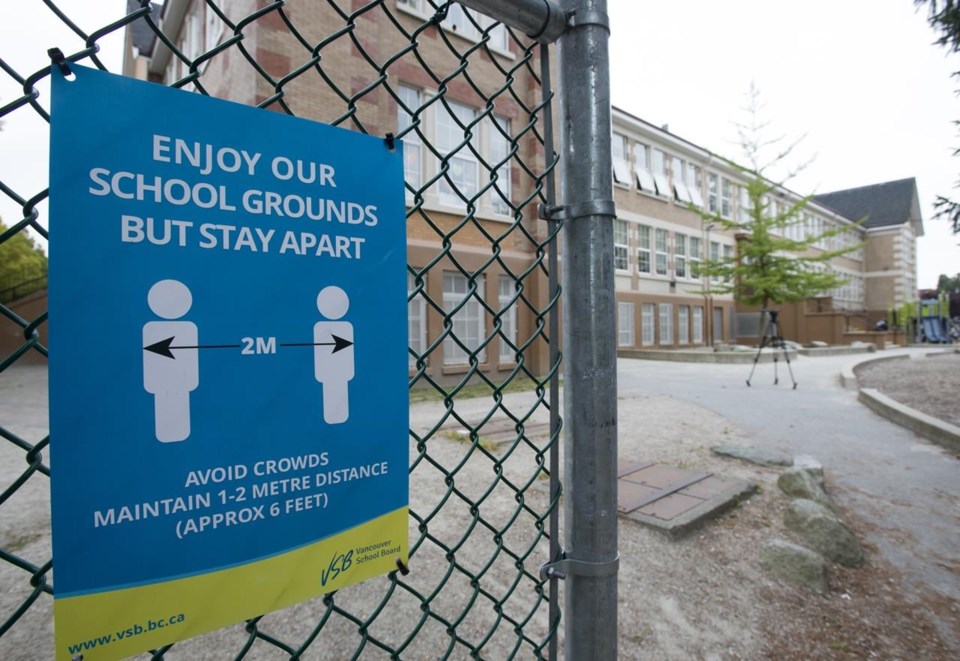SURREY, B.C. — The superintendent of a school district in the centre of British Columbia's COVID-19 storm said it was "eye-opening" to learn that many students aren't showing up to take COVID-19 tests after school-based virus exposures come to light.
Jordan Tinney of Surrey Schools disclosed the trend in a Sunday blog post, suggesting socio-economic inequality and the extra pressures the pandemic places on low-income families could be playing a role.
In a case where 100 letters were sent home advising students that COVID-19 tests had been arranged for them because of an exposure, more than one third did not show up, he said.
"Those are typically in areas where there is high poverty," he said in an interview.
Tinney said he's concerned that some families may be worried that a test will lead to a self-isolation order, stoking fears that members could lose their jobs if they don't show up to work. Others may be reluctant to skip class if they rely on school breakfast programs and other supports, he added.
The learning outcomes may also be different for a student who goes home to high-speed internet and multiple smart devices compared to another who self-isolates in a two-bedroom apartment with nine family members, he said.
Tinney's blog post cited a study from the University of British Columbia that identified a link between low socio-economic status and high health risk. The resulting cycle, researchers concluded, can result in "COVID-induced poverty" for low-income families.
"I don't necessarily think we've talked enough so far about how COVID descends on different communities in a way that isn't equitable," Tinney said.
Tinney published the blog the same day he released a video outlining new measures the district is pursuing to strengthen health and safety protocols at schools with higher infection rates, although he noted those schools aren't all in low-income areas.
Schools with high exposure rates tend to be overcrowded and located in communities with high case rates regardless of income level, Tinney said.
The new strategy involves more intensive support for schools with repeated exposures and a targeted approach for those located in communities with high virus prevalence.
Some improvements will be universal, like requiring teachers to organize classrooms to create as much physical distance as possible.
Measures for hardest-hit facilities include prohibiting parents from entering schools without the principal's permission, asking students to leave the premises right after class and increasing monitoring of staff rooms.
Matthew Westphal, president of the Surrey Teachers Association, said in a tweet that the new changes are a step in the right direction.
"The new changes for Surrey are an improvement, but without a mask mandate they are still just nibbling around the edges of the real problem: too many bodies packed into a small space, breathing the same air all day," he said.
Masks are required for B.C.'s high school and middle school students in common areas, but not while sitting at their desks. They remain a personal choice for elementary students.
Tinney said the measures involve strengthening and expanding what is possible within the existing public health orders, but initiatives like expanding mask rules are outside the district's power.
The province's Education Ministry said in a statement that neither the ministry nor schools have the authority or expertise to set public health policy in a pandemic. Only provincial or regional medical health officers can do that, the statement noted.
It said that while Surrey schools have had a number of exposure events, there have been low rates of in-school transmission, suggesting existing protocols are effective.
The ministry referred a question about whether testing challenges have aligned with socio-economic inequality to the ministry of health, which did not immediately respond to request for comment.
Tinney said COVID-19 cases are not distributed evenly throughout the district. About one third of schools have issued two or fewer letters to date, while such notices are weekly occurrences at others.
"It is intense, it is exhausting for those staff to receive an unending stream of letters and notices," he said in the video.
Overcrowding in schools is a major factor, he said, noting that 13 out of 20 secondary schools in the district are operating at a combined average capacity of 122 per cent.
— By Amy Smart in Vancouver.
This report by The Canadian Press was first published March 14, 2021.
The Canadian Press



